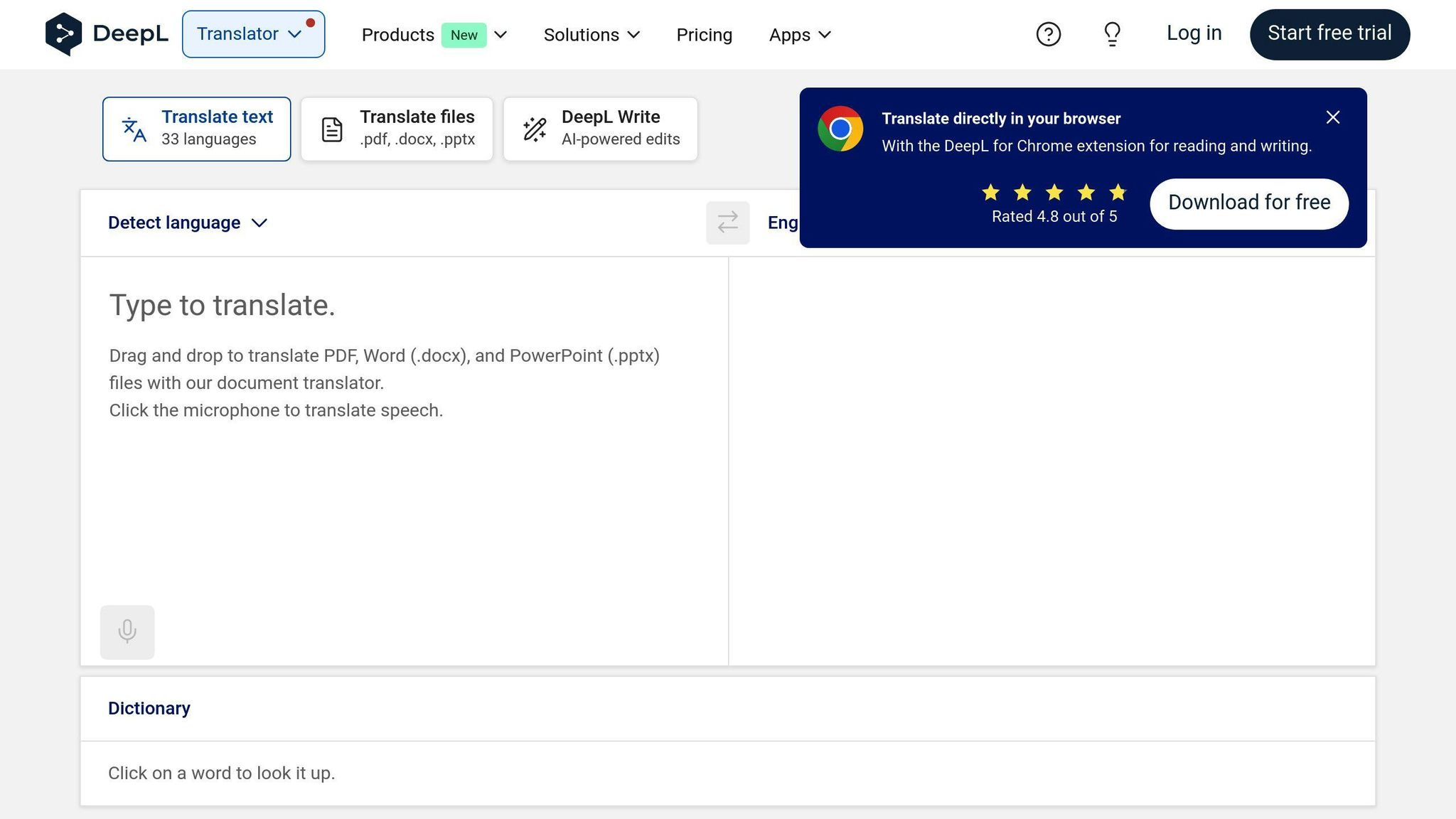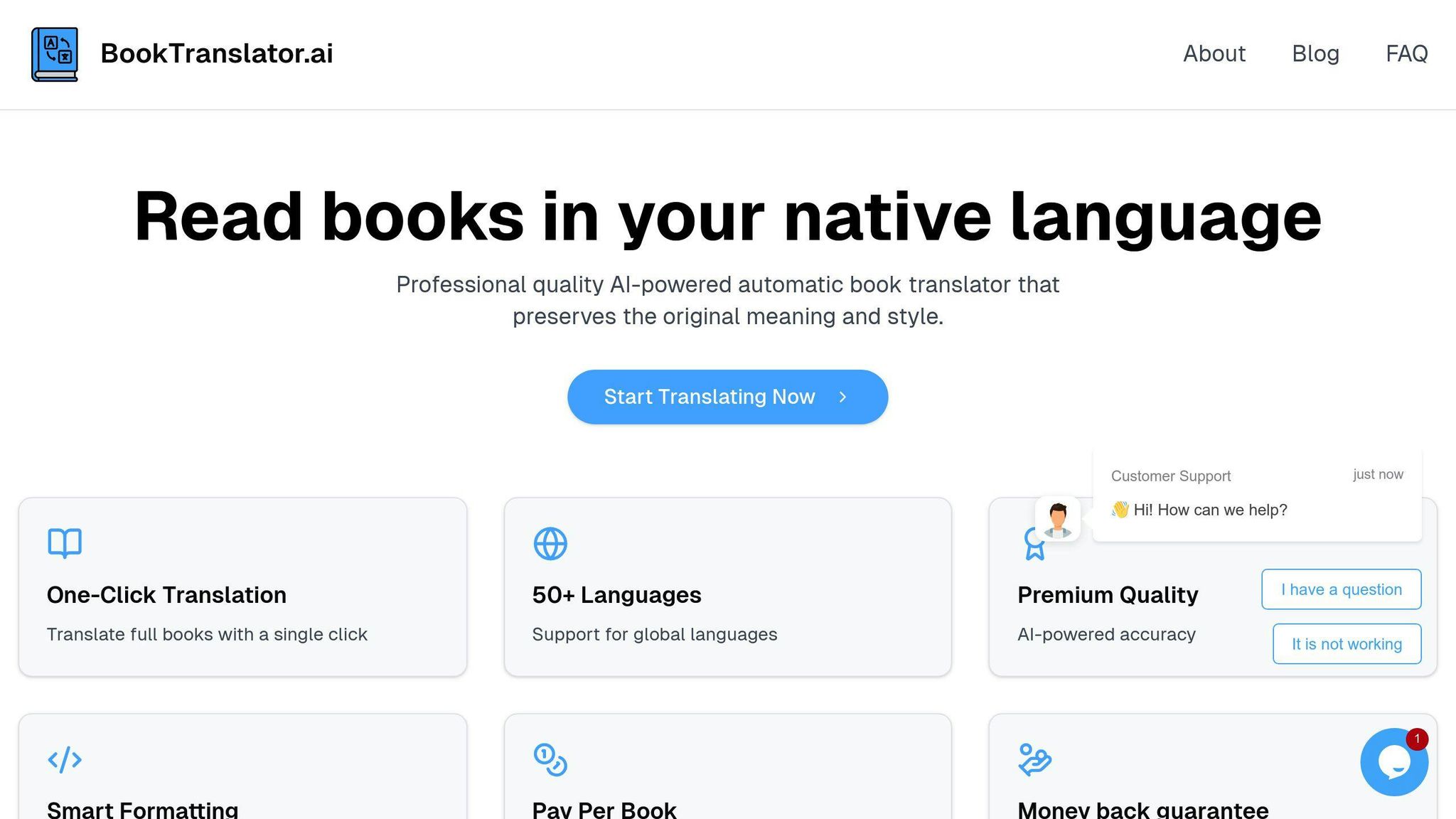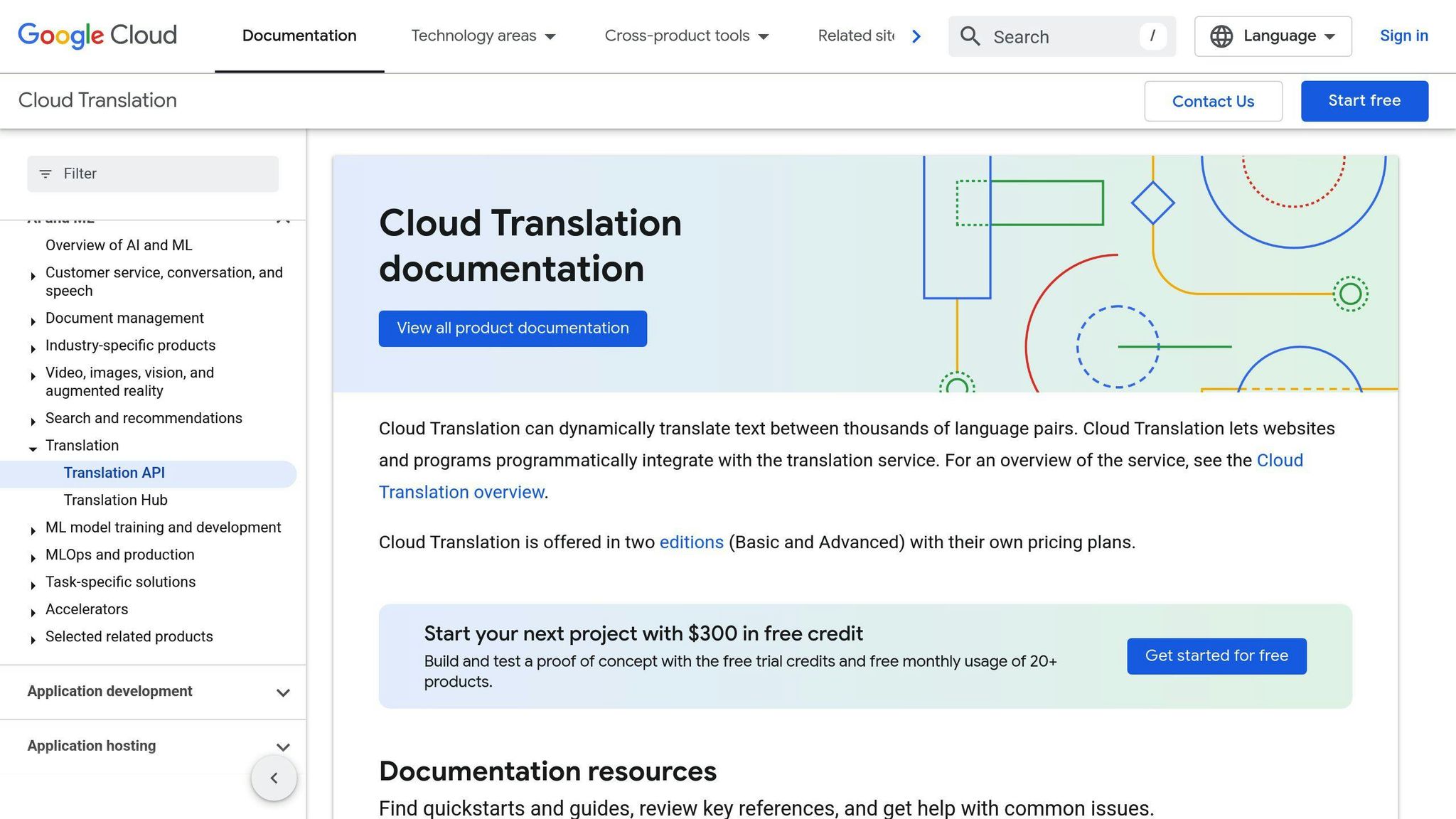
Best Tools for Translating Foreign Language Books
Looking to translate books into other languages? Here’s a quick rundown of the best tools available:
- BookTranslator.ai: Tailored for books, supports 99+ languages, preserves EPUB formatting, and starts at $5.99 per 100,000 words.
- Google Translate API: Covers 133+ languages, great for general content, but struggles with literary nuances. Free tier available; paid plans scale with usage.
- DeepL: Known for its precision with European languages, offers glossary tools and tone adjustments. Starts at $8.74/month.
Quick Comparison
| Feature | BookTranslator.ai | Google Translate API | DeepL |
|---|---|---|---|
| Translation Accuracy | High for books | Moderate | Excellent for European languages |
| Language Support | 99+ languages | 133+ languages | 31 languages |
| Formatting | Strong EPUB support | Basic formatting | Document-focused |
| Pricing | $5.99-9.99/100k words | Free tier + paid API | From $8.74/month |
For casual readers, Google Translate is a free, quick option. For professional publishing, DeepL excels with context-aware translations, while BookTranslator.ai is ideal for authors needing polished EPUB formatting. Combine tools for the best results!
DeepL vs Google Translate - Which Language Translator is Better?

1. BookTranslator.ai

BookTranslator.ai is a platform tailored specifically for translating books, powered by advanced AI technology. Here's a closer look at what it offers for authors and publishers.
Translation Quality
The platform relies on cutting-edge AI to provide translations that maintain the original meaning, context, and subtle nuances of the source material [2]. This is especially critical for literary works, where tone and style can make or break the reading experience.
Wide Language Coverage
With support for over 99 languages, BookTranslator.ai helps authors and publishers connect with readers across the globe [2].
Maintains Formatting
BookTranslator.ai ensures that the layout, styling, and EPUB formatting (up to 50MB) remain intact during translation. This guarantees a polished, professional look for the translated work.
Cost and Speed
The service starts at $5.99 per 100,000 words for basic plans, while Pro plans, which offer even greater accuracy, are priced at $9.99 per 100,000 words. Translations are completed in under a minute [2], and new users are backed by a money-back guarantee.
While BookTranslator.ai is designed with books in mind, broader tools like Google Translate API may be worth considering for other translation needs.
2. Google Translate API

Google Translate API is a widely used tool for translation projects, including book translations. It offers broad accessibility and scalability, but achieving high-quality literary translations may require additional work.
Translation Accuracy
Powered by advanced AI, Google Translate API delivers reliable results for general content. However, it often struggles with capturing the subtle cultural and stylistic elements essential to literary works [1]. While it handles straightforward text well, idiomatic expressions and complex literary nuances can be challenging for the tool.
Language Support
With support for over 100 languages, including less commonly used ones, Google Translate API is a strong option for reaching global audiences [1]. This extensive language coverage allows publishers to connect with diverse markets while maintaining consistent translation quality across various language combinations.
Formatting Preservation
The tool does a good job of retaining basic formatting but might need manual adjustments for books with intricate layouts [3]. Key features include:
| Feature | Capability |
|---|---|
| Document Translation | Maintains basic text formatting |
| Real-time Processing | Efficiently handles large text volumes |
Pricing
Google Translate API offers a range of pricing options:
- A free version with limited translation capacity
- Paid API access for larger-scale projects
- Costs are based on the number of characters translated, making it affordable for smaller tasks but potentially pricey for long manuscripts [1]
To manage costs and maintain quality, experts suggest breaking large texts into smaller sections for translation [3].
While Google Translate API is a versatile tool, alternatives like DeepL might be better suited for projects requiring more refined literary translations.
sbb-itb-0c0385d
3. DeepL
DeepL is a powerful AI-driven tool, often chosen for translating books with precision. As a widely-used machine translation service outside of Big Tech, it stands out for its capabilities in handling literary content.
Translation Quality and Language Coverage
DeepL is known for its ability to handle the subtleties of literary translations, especially for European languages. It supports 31 languages and uses AI to interpret context and tone effectively, making it an excellent option for translating books. Professional translators consistently rank DeepL higher than its competitors for European language translations [3]. While its focus is on major European and a few Asian languages, this narrower scope allows it to prioritize quality over quantity.
Formatting and Features
DeepL also preserves the original formatting of documents across formats like PDFs and Word files. Some standout features include:
- Glossary tools to ensure consistent terminology throughout longer texts
- Tone options for formal or informal translations in certain languages
Pricing
DeepL offers a free version for basic use, with paid plans starting at $8.74/month. These plans include advanced features and API access for professional needs [3]. Although its pricing is slightly higher than some alternatives, its ability to handle complex literary translations makes it a worthwhile investment.
DeepL delivers outstanding quality for supported languages, but its narrower language selection and higher price point might not fit every project. Compared to tools like BookTranslator.ai and Google Translate API, DeepL focuses on delivering top-tier translations for a select range of languages, catering to users who prioritize precision over broad coverage.
Advantages and Disadvantages
After reviewing the features of each tool, let's break down their strengths and limitations to help you decide which one fits your needs best.
| Feature | BookTranslator.ai | Google Translate API | DeepL |
|---|---|---|---|
| Translation Accuracy | High for general content | Moderate, varies by language | Excellent for European languages |
| Language Support | 99+ languages | 133+ languages | 31 languages |
| Formatting Preservation | Strong EPUB support | Basic | Document-focused |
| Pricing | $5.99-9.99/100k words | Free tier + paid API | From $8.74/month |
| Special Features | EPUB-specific tools | Web integration | Custom terminology, tone options |
BookTranslator.ai stands out for its focus on book translation and EPUB formatting. Its platform offers reliable results, though it has fewer user reviews compared to its more established competitors.
Google Translate API offers the broadest language coverage, which is especially useful for rare language pairs. Its free tier is great for small projects, but the translation quality can vary, especially for content that requires cultural context or literary nuance.
DeepL is known for its top-tier accuracy in European languages and advanced features like custom terminology and tone adjustments. However, its relatively limited language support and subscription pricing might not work for everyone.
Key Factors to Consider:
- Project Scale: BookTranslator.ai is ideal for one-off projects, while DeepL's subscription model is better for ongoing needs.
- Language Pairs: Google Translate API is a go-to for less common languages.
- Content Type: DeepL's precision makes it worth the cost for translating literary works in supported languages.
- Budget: Google Translate's free tier is a cost-effective way to start small projects or test translations.
For the best results, consider combining tools. For instance, use DeepL for detailed literary passages, Google Translate for less common languages, and BookTranslator.ai for finalizing EPUB formatting. This hybrid approach lets you leverage the strengths of each tool effectively.
Now that we've covered the advantages and limitations, you might still have specific questions about translating books. Let's tackle some common concerns.
Conclusion
The world of book translation is changing fast, offering a variety of tools for different needs.
For personal reading, Google Translate is a practical option. With support for 133 languages and its easy accessibility, it’s perfect for casual readers who want quick translations without worrying about literary precision. The free tier makes it a great starting point for anyone exploring foreign language books.
For professional publishing, DeepL Pro stands out, particularly for European languages. Its high accuracy and ability to maintain HTML formatting make it a strong choice for publishers working with digital content. Starting at $8.74/month, it’s a cost-effective option for regular translation needs.
If you’re working with EPUB formats, BookTranslator.ai is a specialized tool worth considering. Its pricing ($5.99-9.99 per 100,000 words) and focus on preserving formatting make it appealing for independent authors and smaller publishers aiming to reach a global audience.
"AI will not completely replace human translators but will instead transform the translation industry to become more efficient and productive." - Aorinka Anendya
Depending on your goals, here’s how these tools can match specific needs:
1. For Literary Works
DeepL’s context-aware translations and precision make it a strong choice for translating complex literary content, especially in European languages.
2. For Technical Books
BookTranslator.ai is ideal for technical publications, thanks to its ability to maintain complex layouts and formatting.
3. For Global Reach
When broad language coverage is essential, Google Translate API is a reliable option. It supports less common languages and integrates easily with various platforms, making it suitable for reaching readers in emerging markets.
AI tools are reshaping book translation, offering faster processing times - like handling a 10,000-word technical document in just 2–3 days [3]. However, human editors remain essential for ensuring cultural and contextual accuracy, especially in nuanced content.
As neural machine translation improves, expect even more refined and accurate tools to emerge, further enhancing the possibilities for book translation.
FAQs
Can you translate an EPUB book?
Yes, AI tools can translate EPUB books while keeping the original formatting and layout intact. Here's how EPUB translation works and what to keep in mind:
BookTranslator.ai supports EPUB files up to 50MB and works with over 99 languages. It focuses on translating content while maintaining the document's structure.
DeepL offers EPUB translation through its document translation feature, delivering especially strong results for European languages [1].
Tips to get the best results:
- Make sure your EPUB file is within the size limit.
- Verify that your language pair is supported.
- Review the formatting after translation to catch any issues.
Some platforms offer free trials or basic versions, so you can test their performance before committing to a paid plan. For example, BookTranslator.ai includes a money-back guarantee, giving users a chance to assess the translation quality risk-free.
These tools are especially useful for authors and publishers who want to streamline their workflows. For complex literary works, pairing AI translation with human review ensures the best results.